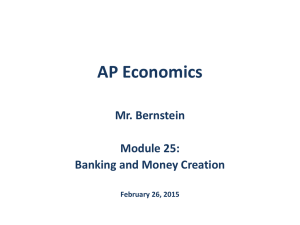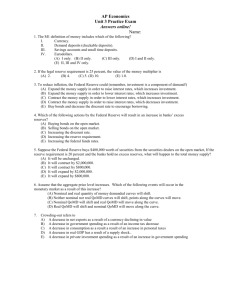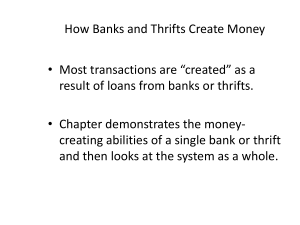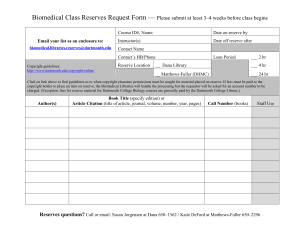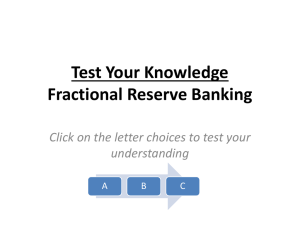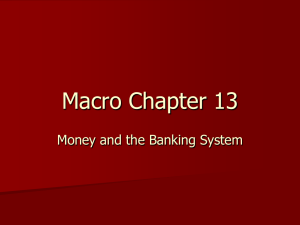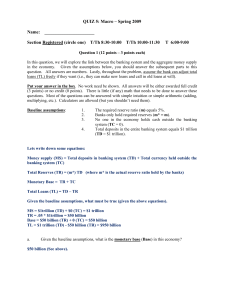chap015Answers
advertisement
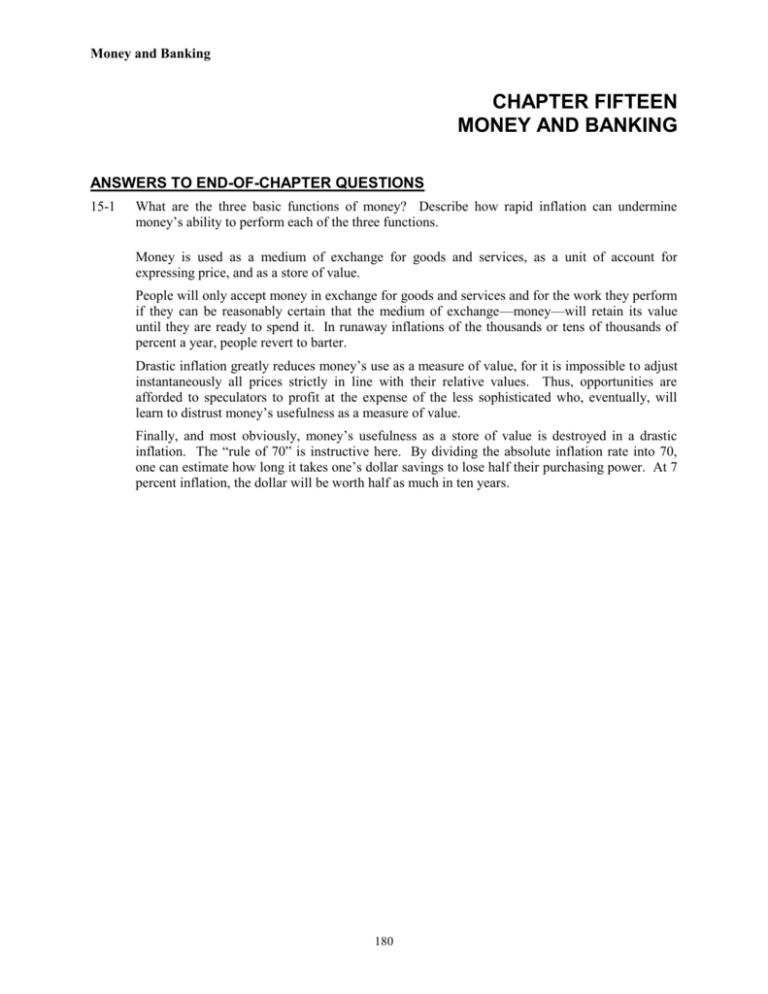
Money and Banking CHAPTER FIFTEEN MONEY AND BANKING ANSWERS TO END-OF-CHAPTER QUESTIONS 15-1 What are the three basic functions of money? Describe how rapid inflation can undermine money’s ability to perform each of the three functions. Money is used as a medium of exchange for goods and services, as a unit of account for expressing price, and as a store of value. People will only accept money in exchange for goods and services and for the work they perform if they can be reasonably certain that the medium of exchange—money—will retain its value until they are ready to spend it. In runaway inflations of the thousands or tens of thousands of percent a year, people revert to barter. Drastic inflation greatly reduces money’s use as a measure of value, for it is impossible to adjust instantaneously all prices strictly in line with their relative values. Thus, opportunities are afforded to speculators to profit at the expense of the less sophisticated who, eventually, will learn to distrust money’s usefulness as a measure of value. Finally, and most obviously, money’s usefulness as a store of value is destroyed in a drastic inflation. The “rule of 70” is instructive here. By dividing the absolute inflation rate into 70, one can estimate how long it takes one’s dollar savings to lose half their purchasing power. At 7 percent inflation, the dollar will be worth half as much in ten years. 180 Money and Banking 15-2 Which two of the following financial institutions offer checkable deposits within the M1 money supply: mutual fund companies, insurance companies, commercial banks, securities firms, thrift institutions? Which of the following is not included in either M1 or M2: currency held by the public; checkable deposits, money market mutual fund balances; small (less than $100,000) time deposits; currency held by banks; savings deposits? Commercial banks and thrift institutions offer checkable deposits. Currency held by banks is not counted in either M1 or M2. 15-3 What are the components of the M1 money supply? What is the largest component? Which of the components is legal tender? Why is the face value of a coin greater than its intrinsic value? What near-monies are included in M2 money supply? M1 = currency (in circulation) + checkable deposits. The largest component of M1 is currency (51 percent), and it is the only part that is legal tender. If the face value of a coin were not greater than its intrinsic (metallic) value, people would remove coins from circulation and sell them for their metallic content. M2 = M1 + noncheckable savings deposits + money market deposit accounts + small time deposits + money market mutual fund balances. 15-4 How does the purchasing power of the dollar relate to the nation’s price level? The value or purchasing power of money is inversely related to the price level. As prices rise, each dollar buys less than it did before. 15-5 Who selects the chairperson of the Federal Reserve System? Describe the relationship between the Board of Governors of the Federal Reserve System and the 12 Federal Reserve Banks. What is the composition and purpose of the Federal Open Market Committee (FOMC)? The president selects (and the senate confirms) the chairperson of the board from among the members of the Board of Governors. Several entities assist the Board of Governors in determining banking and monetary policy. The Federal Open Market Committee is the most important, voting on the Fed’s monetary policy and directing the purchase or sale of government securities. It has twelve members: the seven governors plus five of the presidents of the Federal Reserve Banks. The banks rotate the membership among the 12 banks, except for the president of the NY Fed, who has a permanent voting seat. 15-6 What is meant when economists say that the Federal Reserve Banks are central banks, quasipublic banks, and bankers’ banks? What are the seven basic functions of the Federal Reserve System? The 12 Federal Reserve Banks are “central” banks whose policies are coordinated by the Board of Governors. They are quasipublic banks, meaning that they are a blend of private ownership and public control. They are also banker’s banks in that they perform essentially the same functions for banks and thrifts as those institutions perform for the public. The Federal Reserve performs 7 basic functions: 1. The Fed issues Federal Reserve Notes, the paper currency used in the U.S. monetary system. 2. The Fed sets reserve requirements and holds the mandated reserves that are not held as vault cash. 181 Money and Banking 3. The Fed lends money to banks and thrifts. 4. The Fed provides for check collection. 5. The Fed acts as fiscal agent for the Federal government. 6. The Fed supervises the operation of banks. 7. Finally, and most importantly, the Fed has responsibility for regulating the supply of money, and this in turn enables it to affect interest rates. 15-7 Why must a balance sheet always balance? commercial bank’s balance sheet? What are the major assets and claims on a A balance sheet is a statement of assets and claims (or liabilities and net worth). It must balance because every asset is claimed by someone, so that assets (the left-hand side) = liabilities + net worth (the right-hand side). The major assets of a bank are: cash (including cash reserves held by the Fed), its property, and the loans it has made. Its liabilities are the deposits of its customers. The difference between the assets and liabilities is the bank’s net worth, which is shown on the liabilities side, thus ensuring that the balance sheet balances. 15-8 Why does the Federal Reserve require that commercial banks have reserves? What are excess reserves? How do you calculate the amount of excess reserves held by a bank? What is the significance of excess reserves? Reserves provide the Fed a means of controlling the money supply. It is through increasing and decreasing excess reserves that the Fed is able to achieve a money supply of the size it thinks best for the economy. Excess reserves are the amount by which actual reserves exceed required reserves: Excess reserves: Excess reserves = actual reserves - required reserves [where actual reserves consist of vault cash plus reserves deposited with the Fed, and required reserves are found by multiplying the reserve ratio times deposit liabilities]. Commercial banks can safely lend excess reserves, thereby increasing the money supply. Controlling the amount of excess reserves, therefore, is vital to controlling the money supply. 15-9 “Whenever currency is deposited into a commercial bank, cash goes out of circulation and, as a result, the supply of money is reduced.” Do you agree? Explain why or why not. The M1 money supply consists of currency outside of the banks (cash in the hands of the public) and checking account deposits of the public in the commercial banks. The deposit of currency into a checking account in a bank has changed the form of the money supply but not the amount. If, however, the money is deposited into a savings account, M1 will fall, but M2 will not. 15-10 Explain why a single commercial bank can safely lend only an amount equal to its excess reserves but the commercial banking system can lend by a multiple of its excess reserves. What is the monetary multiplier, and how does it relate to the reserve ratio? When a bank grants a loan, it can expect that the borrower will not leave the proceeds of the loan sitting idle in his or her account. Most people borrow to spend. Therefore the lending bank can expect that checks will be written against the loan and that the bank will shortly lose reserves to 182 Money and Banking other banks, as the checks are presented for payment, to the full extent of the loan. In short, when a bank grants loans to the full extent of its excess reserves, it can shortly expect to lose these excess reserves to other banks. From this it can be seen why a bank cannot safely lend more than its excess reserves. If it did, it would soon find its cash reserves below its legal reserve requirement. From the above it can be seen why the commercial banking system can safely lend a multiple of its excess reserves. Whereas one bank loses reserves to other banks, the system does not. With a legal cash reserve requirement of, say, 20 percent, Bank “B” on receiving as a new deposit the $100 loaned by Bank “A” (the excess reserves of Bank “A”), may safely lend $80 (80 percent of $100). Bank “C”, on receiving as a new deposit the $80 loan of Bank “B”, loans 80 percent of that, namely $64. Note that the $100 initial excess reserves of the banking system have already resulted in the money supply increasing by $244 (= $100 + $80 + $64). The money supply will continue to increase, at a diminishing rate (Bank “D” will increase the money supply by $51.20 in loaning this amount), until the total increase in the money supply is $500. The algebra underlying the monetary multiplier (for those students interested) is that of an infinite geometric progression. Designating the fixed fraction of the previous number as b (0.8 in our case) and k as the sum of the progression, we have: k 1 b b2 b3 ...... bn Solving this for a very large n, we get, k 1 / 1 b In our example, the multiplier k is 1/(1 - 0.8) = 1/.2 = 5. And 5 is the reciprocal of the reserve ratio of 20 percent of 0.2. The multiplier is inversely related to the reserve ratio. 15-11 Suppose the National Bank of Commerce has excess reserves of $8,000 and outstanding checkable deposits of $150,000. If the reserve ratio is 20 percent, what is the size of the bank’s actual reserves? Required reserves = 20 percent of $150,000 = $30,000 Therefore, required reserves = $30,000; Excess reserves = $ 8,000; Actual reserves = $38,000. 15-12 Suppose that Continental Bank has the simplified balance sheet shown below and that the reserve ratio is 20 percent: Liabilities and net worth (1) (2) Assets (1) (2) Reserves Securities Loans $22,000 38,000 40,000 Checkable deposits $100,000 _____ _____ a. What is the maximum amount of new loans that this bank can make? Show in column 1 how the bank’s balance sheet will appear after the bank has lent this additional amount. b. By how much has the supply of money changed? Explain. 183 Money and Banking c. How will the bank’s balance sheet appear after checks drawn for the entire amount of the new loans have been cleared against this bank? Show this new balance sheet in column 2. (a) $2,000. Column 1 of Assets (top to bottom): $22,000; $38,000; $42,000. Column 1 of Liabilities: $102,000. (b) $2,000. The bank has lent out its excess reserves, creating $2,000 of new demand-deposit money. (c) Column 2 of Assets (top to bottom): $20,000; $38,000; $42,000. Column 2 of Liabilities; $100,000. 15-13 Suppose the simplified consolidated balance sheet shown below is for the entire commercial banking system. All figures are in billions. The reserve ratio is 25 percent. Assets Liabilities and Net Worth (1) Reserves Securities Loans $ 52 ___ 48 ___ 100 ___ (2) Checkable deposits $200 ___ a. What amount of excess reserves does the commercial banking system have? What is the maximum amount the banking system might lend? Show in column 1 how the consolidated balance sheet would look after this amount has been lent. What is the monetary multiplier? b. Answer the questions in part a assuming that the reserve ratio is 20 percent. Explain the resulting difference in the lending ability of the commercial banking system. (a) Required reserves = $50 billion (= 25% of $200 billion); so excess reserves = $2 billion (= $52 billion - $50 billion). Maximum amount banking system can lend = $8 billion [= (1/.25) x $2 billion]. Column (1) of Assets data (top to bottom): $52 billion; $48 billion; $108 billion. Column (1) of Liabilities data: $208 billion. Monetary multiplier = 4 (= 1/.25). (b) Required reserves = $40 billion (= 20% of $200 billion); so excess reserves = $12 billion (= $52 billion - $40 billion). Maximum amount banking system can lend = $60 billion [= (1/.20) x $12 billion]. Column (1) data for assets after loans (top to bottom); $52 billion; $48 billion; $160 billion. Column (1) data for liabilities after loans: $260 billion. Monetary multiplier = 5 (= 1/.20). The decrease in the reserve ratio increases the banking system’s excess reserves from $2 billion to $12 billion and increases the size of the monetary multiplier from 4 to 5. Lending capacity becomes 5 x $12 = $60 billion. 184


